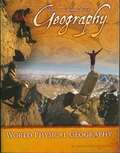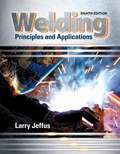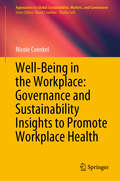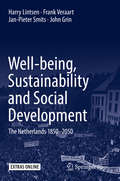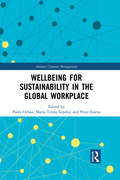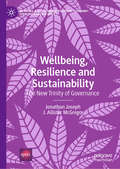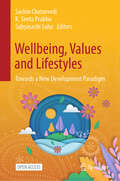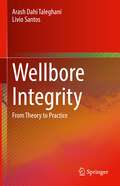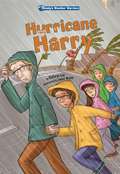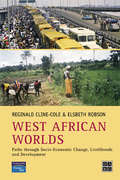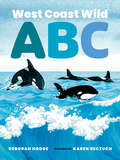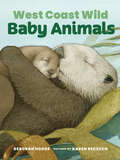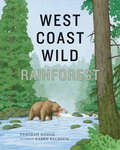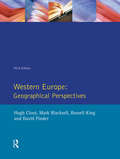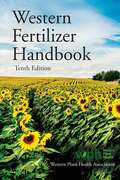- Table View
- List View
Welcome to the Wonderful World of Geography
by Brenda Brewer RunkleAlthough we like to teach geography as it relates to our studies if you prefer a geography textbook, this award-winning one-year curriculum for 6th grade-high school is a good choice. <p><p> Focuses on physical geography providing the basis for learning the fundamentals of geography. The student map workbook is designed for mapping and memorization of every country and its capital.
Welding: Principles And Applications (Eighth Edition)
by Larry JeffusThis proven guide provides the knowledge and skills you need to complete AWS SENSE Level I and Level II programs, create Workmanship Qualification Specimens, and earn professional certification. Advancing rapidly from basic concepts and processes to today's most complex, cutting-edge welding technologies and practices, this comprehensive text features valuable information on topics such as welding metallurgy, metal fabrication, weld testing and inspection, joint design, job costing, and environmental and conservation tips. The author opens each section by introducing you to the materials, equipment, setup procedures, and critical safety information you need to execute a specific process successfully, while subsequent chapters focus on individual welding tasks leading to SENSE certification. Now with MindTap for Welding, complete with simulation and up-to-date welding videos.
Well-Being in the Workplace: Governance and Sustainability Insights to Promote Workplace Health (Approaches to Global Sustainability, Markets, and Governance)
by Nicole CvenkelThis book is intended for human resources management academics, researchers, students, organizational leaders and managers, HR Practitioners, and those responsible for helping support employees in the 21st-century workplace. It offers a path forward to create an environment that will not only build a healthier workplace by providing appropriate and effective well-being interventions but also offers solutions to manage multi-generational and ‘holistic’ employees within the employment relationship. The book describes the factors that promote healthy and WELL organizations and introduces concepts and strategies to reduce workplace stress and mental health issues and improve workplace well-being toward sustained organizational success. Employers that embrace the corporate responsibility of promoting the health and well-being of multi-generational, holistic employees will reap cost savings, employee engagement, and productivity advantages, as well as a healthier and more productive workforce.
Well-being, Sustainability and Social Development: The Netherlands 1850–2050
by Harry Lintsen Frank Veraart Jan-Pieter Smits John GrinThis open access book examines more than two centuries of societal development using novel historical and statistical approaches. It applies the well-being monitor developed by Statistics Netherlands that has been endorsed by a significant part of the international, statistical community. It features The Netherlands as a case study, which is an especially interesting example; although it was one of the world’s richest countries around 1850, extreme poverty and inequality were significant problems of well-being at the time. Monitors of 1850, 1910, 1970 and 2015 depict the changes in three dimensions of well-being: the quality of life 'here and now', 'later' and 'elsewhere'. The analysis of two centuries shows the solutions to the extreme poverty problem and the appearance of new sustainability problems, especially in domestic and foreign ecological systems. The study also reveals the importance of natural capital: soil, air, water and subsoil resources, showing their relation with the social structure of the ‘here and now´. Treatment and trade of natural resources also impacted on the quality of life ‘later’ and ‘elsewhere.’ Further, the book illustrates the role of natural capital by dividing the capital into three types of raw materials and concomitant material flows: bio-raw materials, mineral and fossil subsoil resources. Additionally, the analysis of the institutional context identifies the key roles of social groups in well-being development. The book ends with an assessment of the solutions and barriers offered by the historical anchoring of the well-being and sustainability issues. This unique analysis of well-being and sustainability and its institutional analysis appeals to historians, statisticians and policy makers.
Wellbeing and Self-Transformation in Natural Landscapes
by Rebecca CrowtherThis book explores how natural landscapes are linked to positive mental wellbeing. While natural landscapes have long been represented and portrayed as transformative, the link to mental wellbeing is an area that researchers are still aiming to comprehend. Accompanying five groups of people to rural Scotland, the author considers individual, external and group motivations for journeying from urban environments, examining in what ways these excursions are personally and socially transformative. Far more than traversing mere physical boundaries, this book illustrates the new challenges, experiences, territories and cultures provided by these excursions, firmly anchored in the Scottish countryside. In doing so, the author questions the extent to which people’s own narratives link to the perception that the outdoors are positively transformative – and what indeed does have the power to influence transformation. Grounded in extensive qualitative research, this contemplative and ethnographic book will be of interest and value to students and scholars of the outdoors and its connection to wellbeing.
Wellbeing for Sustainability in the Global Workplace (Human Centered Management)
by Paola Ochoa Maria-Teresa Lepeley Peter EssensWellbeing in the workplace is an essential element in fostering a worker’s sense of being valued, ensuring their engagement, and ultimately leading to higher levels of productivity and organizational performance. This important book specifically adds to the discussion by taking a global perspective, and evaluates wellbeing in the workplace in different countries, identifying both universal issues and specific cultural issues. Chapter authors have been drawn from across five continents and eleven countries to provide ground-breaking research in wellbeing from different regional perspectives, looking at both developed and developing world scenarios. What is clear throughout the book is that organizations that are not people-centered undermine their capacity to attain and maintain quality standards, high performance, and competitiveness. Organizational concerns about workers' wellbeing are growing exponentially due to the global VUCA (volatile, uncertain, complex, ambiguous) environment. In this environment, organizational success is no longer simply based on short-term revenue maximization, capital investments, or sales, but increasingly depends on people’s wellbeing, human capital, and the development of human talent to ensure sustained and sustainable growth and performance. This book presents a collection of studies that address current and forthcoming organizational challenges and offer realistic solutions to support leaders and managers seeking to balance and value the contribution of people with long-term organizational performance.
Wellbeing from Woodland: A Critical Exploration of Links Between Trees and Human Health
by Sue Waite Alice GoodenoughThis book provides a framework for understanding the components of woodland wellbeing. Based around the collaborative project, Good from Woods, the book spotlights multiple case studies to explore how wellbeing and health are promoted in woodland settings and through woodland inspired activity. It illustrates forms of wellbeing through real examples of woodland practice and draws out implications for the design of programmes to support health and wellbeing across different client groups. Chapters discuss health and wellbeing from a variety of perspectives such as psychological, physical, social, emotional and biophilic wellbeing.The book will be of great practical use to commissioners, providers and users of woodland based activity who want to take a deeper look into how trees, woods and forests support human health and happiness, as well as of interest to academics and students engaged in research in outdoor activities, urban forestry and natural health and wellbeing.
Wellbeing, Justice and Development Ethics
by Severine DeneulinThe question of the meaning of progress and development is back on the political agenda. How to frame this discontent and search for new alternatives when either Marxism or liberalism no longer provides a satisfactory framework? This book introduces in an accessible way the capability approach, first articulated by Amartya Sen in the early 1980s. Written for an international audience, but rooted in the Latin American reality - a region with a history of movements for social justice - the book argues that the capability approach provides to date, the most encompassing and compelling ethical framework with which to construct action for improving people’s wellbeing and reducing injustices in the world. This book outlines in a clear and concrete way what the capability approach is and its significance for the social sciences and policy. It describes the distinctiveness of the approach as an ethical framework for action and aims to stimulate critical reflection on current economic and social practices as well as providing a language with which to modify them within human wellbeing concerns. Comprehensive, practical and nuanced in its treatment of the capability approach, this highly original volume gives students, researchers and professionals in the field of development an innovative framing of the capability approach as a 'language' for action and provides specific examples of how it has made a difference.
Wellbeing, Nature, and Moral Values in Economics: How Modern Economic Analysis Faces the Challenges Ahead (Routledge Frontiers of Political Economy)
by Heinz WelschDrawing on more modern expressions of economic analysis, this book explores the interplay between wellbeing, nature and moral values in economics. In standard accounts of economics, these three themes are typically treated in isolation from each other, or else overlooked entirely. This book argues that due to this blinkered approach, standard economic analysis is poorly equipped to deal with global contemporary challenges including climate change, biodiversity loss, sustainability, and the risk of pandemic diseases. The book reviews the economic literature to show that the last few decades has seen the re-insertion into economic analysis of human wellbeing, natural resources and moral values: three themes present in early economic thought that are highly relevant to the challenges ahead. The book argues for the greater integration of these three themes as the natural environment is crucial to human wellbeing, and moral values are essential for environmentally benign behaviors. The book also focuses on how specific moral values, identified by contemporary moral psychology, actually shape economic behavior rather than how abstract ethical principles they should shape economic behavior. The book will be of significant interest to readers in the economics and social sciences, particularly behavioral economics and social psychology.
Wellbeing, Resilience and Sustainability: The New Trinity of Governance (Building a Sustainable Political Economy: SPERI Research & Policy)
by Jonathan Joseph J. Allister McGregorWellbeing, resilience and sustainability are three of the most popular ideas in current usage and are said to represent a much-needed paradigm shift in political and policy thinking. This book is unique in bringing the three concepts together as representing a new trinity of governance. Here we introduce some of the commonalities between the ideas, particularly their concern with distinctive human capacities that shape who we are and that imply a particular relationship to our wider social and natural environments. The book explains what is distinctive about the three ideas and why they are currently popular. In particular, we are concerned with how these ideas contribute to governance ‘after the crisis’, and how questions of social, political and economic uncertainty influence the ways in which these main arguments are developed. The book will appeal to those studying these ideas, how they apply to politics, political economy and governance, and to the wider public and policy-makers in these fields.
Wellbeing, Values and Lifestyles: Towards a New Development Paradigm
by Sachin Chaturvedi Sabyasachi Saha K. Seeta PrabhuThis open access book with contributions by leading global experts from diverse specialization defines a new development paradigm built on Lifestyle for Environment (LiFE). The volume outlines the contours of LiFE across five facets namely ethics and value system; sustainable consumption and production; modalities of systemic transformation; financing for resilient infrastructure, cities and societies; and wellbeing measurement going beyond GDP. The book prepared as part of the Think 20 (T20) India Task Force 3 on “LiFE, Resilience and Values for Wellbeing” presents deep insights on socio-economic transformation and ecological balance from a multi-disciplinary perspective. It highlights the importance of normative frameworks in economic thinking, equitable access to finance and technology, role of social enterprises, and imperatives for measuring wellbeing. The book is a must-have resource for political leadership, legislators, policy makers, diplomats, and international organizations in addition to the academic community.
Wellbore Integrity: From Theory to Practice
by Arash Dahi Taleghani Livio SantosThere have been concerns about the integrity of thousands of wells drilled worldwide for different purposes ranging from oil and gas to geological carbon sequestration. This is the first book to integrate different aspects of wellbore integrity into a single volume. It looks at the energy sector's green wave movement by expanding an important topic for practitioners, regulators, and students. It is an area where petroleum and subsurface engineers will increasingly need to be involved in the future to address growing expectations regarding environmental impacts and sustainability. Coverage also includes recent developments in regulations and R&D with indications on emerging areas.Wellbore Integrity: From Theory to Practice will be a valuable resource for practicing engineers and students working on problems related to subsurface energy, subsurface disposals, and environmental impacts of oil and gas wells. In parallel, it will be a valuable reference for engineers and scientists interested in repurposing existing wells for carbon sequestration or geothermal purposes.
Wendy’s Weather Warriors: Hurricane Harry
by Kathryn LayWendy wins an essay contest and gets to take the Weather Warriors and Mr. Andrews to Galveston, Texas, to read her essay about the big 1900 hurricane in Galveston. Now a real tropical storm strikes.
West African Worlds: Paths Through Socio-Economic Change, Livelihoods and Development (Developing Areas Research Group)
by Elsbeth Robson Reginald Cline-ColeWest African Worlds provides a critical assessment of social, economic and political change in Africa’s most populous and arguably most externally focused region. With an emphasis on globalisation and modernisation, case studies and commentary are integrated throughout to highlight the concerns and issues of the region.Enriched by an impressive mix of West African voices, this text combines theory and application with policy and practice to address socio-economic change, the pursuit of livelihoods, and development within West Africa.
West Coast Wild ABC (West Coast Wild #3)
by Deborah HodgeExplore the wild and wonderful Pacific west coast from A to Z! Bears amble, cougars prowl and eagles nest in this beautiful nature alphabet book celebrating the Pacific west coast. Babies and toddlers will delight in the gorgeous watercolor illustrations and fascinating creatures that inhabit the ancient rainforest, rugged beach and majestic Pacific Ocean. Large upper and lowercase alphabet letters on each page encourage letter recognition. Key Text Features illustrations
West Coast Wild Babies (West Coast Wild #2)
by Deborah HodgeIn this second book in the West Coast Wild series, readers will meet the baby animals born in the pristine wilderness of the Pacific west coast, including land and marine mammals, fish, birds and amphibians. It’s spring on the Pacific west coast and new life is stirring! Wild babies are being born — in the ocean, on the shore and deep inside the ancient rainforest. Wolf pups, cougar kittens, bear cubs and whale calves all begin their life in the pristine wilderness of this magnificent place. Young readers will meet a fascinating group of fourteen wild baby animals — including land and marine mammals, fish, birds and amphibians — and learn about the special bonds between offspring and parents, and how the newborns move toward independence. Readers will see an extraordinary community of animals thriving in an interconnected web of life. In this second book in the West Coast Wild series, Deborah Hodge takes readers through the spectacular land and seascapes of the Pacific Rim region, introducing familiar animals such as sea otters and eagles, and lesser known species such as pelagic cormorants and rufous hummingbirds. Karen Reczuch’s beautiful illustrations are detailed and lifelike, and convey a lovely sense of warmth between the wild parents and their young. The text and art have been carefully checked for scientific accuracy. Includes a note about the Pacific west coast and the need to preserve its rare and awe-inspiring wilderness regions, as well as a list for further reading and exploration. Key Text Features further reading illustrations informational note author's note Correlates to the Common Core State Standards in English Language Arts: CCSS.ELA-LITERACY.RL.1.5 Explain major differences between books that tell stories and books that give information, drawing on a wide reading of a range of text types.
West Coast Wild Baby Animals (West Coast Wild)
by Deborah HodgeMeet the wild baby animals of the Pacific west coast! Wolf pups, bear cubs, whale calves and eaglets are thriving in the ancient rainforest, rugged beach and majestic ocean of the Pacific west coast. This sweet introduction to baby animal names and behaviours, with gorgeous watercolor scenes, will delight toddlers and babies everywhere! Key Text Features illustrations
West Coast Wild Rainforest (West Coast Wild #5)
by Deborah HodgeStep into the majestic rainforest of the Pacific west coast and discover a unique community of creatures thriving in an interconnected web of life. Towering over the sea, along the magnificent Pacific west coast, is an ancient and beautiful rainforest with a unique ecosystem that is linked in many ways. In this fourth book in the West Coast Wild series, you will find trees as tall as twenty-storey buildings, tiny seedlings sprouting on nursery logs and brightly colored salmon spawning in streams. The salmon, as a keystone species, connect the ocean to the forest and provide a rich source of food for the bears, wolves, eagles and other creatures that live in this pristine wilderness. The remains of the fish add vital nutrients to the forest, feeding the lush green plants and trees. In turn, the thick vegetation shades the streams and protects the baby salmon that hatch and swim to the sea. Author Deborah Hodge provides a clear and engaging look at the interdependence of the forest species and the fascinating cycles of nature in this rare ecosystem, while Karen Reczuch’s lavish watercolors show the rainforest teeming with life in shades of green that can only come from receiving more than ten feet of rain a year. Key Text Features illustrations author’s note further information further reading facts Correlates to the Common Core State Standards in English Language Arts: CCSS.ELA-LITERACY.RI.K.3 With prompting and support, describe the connection between two individuals, events, ideas, or pieces of information in a text. CCSS.ELA-LITERACY.RI.K.7 With prompting and support, describe the relationship between illustrations and the text in which they appear (e.g., what person, place, thing, or idea in the text an illustration depicts). CCSS.ELA-LITERACY.RI.1.3 Describe the connection between two individuals, events, ideas, or pieces of information in a text. CCSS.ELA-LITERACY.RI.1.4 Ask and answer questions to help determine or clarify the meaning of words and phrases in a text.
West Coast Wild at Low Tide (West Coast Wild #4)
by Deborah HodgeExplore the wild shoreline of the majestic Pacific west coast and discover the spectacular array of colorful creatures living in rhythm with the tides. At the edge of the Pacific Ocean, where land and sea meet, lies a narrow strip of beach called the intertidal zone. Endless tides move back and forth across the zone twice a day. A remarkable community of hardy shoreline creatures flourishes in this environment of ever-changing conditions. In this third book in the West Coast Wild series, readers will meet brightly colored sea stars, a giant Pacific octopus, busy hermit crabs, delicate sand dollars, fish that camouflage and other intriguing marine animals that a child might see on a beach walk at low tide. Author Deborah Hodge relates fascinating facts about each of the fourteen creatures, while Karen Reczuch’s vibrant watercolor illustrations bring the magnificent shoreline and its unique inhabitants to life. Includes a note about the west coast intertidal zone and safety tips for beachcombers, as well as a further reading list. Key Text Features additional information author's note explanation facts further reading illustrations Correlates to the Common Core State Standards in English Language Arts: CCSS.ELA-LITERACY.RI.K.1 With prompting and support, ask and answer questions about key details in a text. CCSS.ELA-LITERACY.RI.K.3 With prompting and support, describe the connection between two individuals, events, ideas, or pieces of information in a text.
West to East: Achieving the SDGs
by Arno J. van NiekerkThis book covers new trends in the global economy as a result of geopolitical shifts. Given the rise of the East (especially China and India) and strong Arab economies in the Middle East, clear signs are emerging that the axis of power may be shifting from the West (America and Europe) to the East. This shift—including any intentions towards de-dollarization—plus its implications need to be thoroughly investigated. In addition, the influence of the digital revolution in finance (cryptocurrencies, CBDCs, FinTech, etc.) are changing the global landscape. What also cannot be overlooked, are the disruptive effects caused by the new Trump administration in the United States on the global economy. A key question is what are the implications of these significant global developments for economic sustainability? Are researchers and policymakers seeing a new form of capitalism emerging or is it new socialism? Achieving the Sustainable Development Goals (SDGs) remain a high priority to most countries around the world, but the progress of many has been derailed by the COVID-19 pandemic. If economic inclusion—as part of the SDGs—remains a central objective, these latest developments will have a significant impact on it going forward, especially in view of growing geopolitical tension. The role of global economic institutions will be crucial in furthering globalization or preventing de-globalization. A higher level of international collaboration, especially from an inclusive economic perspective, will be needed to steer the global economy in a direction that will result in genuine economic progress for all. Addressing all these aspects, the book specifically includes the following special features: comparative trends (graphs and tables) of the geopolitical and geoeconomic shifts over the past few decades; illustrations of changes in the financial system; new analyses of traditional economic theories (e.g., capitalism and socialism); criteria for an inclusive economy and how they help to attain the SDGs; new dissections of the digital revolution in the context of the geopolitical shifts; and proposals on how to deal with the challenges from a global economic governance perspective. Sustainable economic progress is paramount, but the challenge of balancing global priorities, geopolitical forces, and inclusive innovation, requires comprehensive investigation. In a world where power is fluctuating, technologies are transforming the economy, and global norms are being rewritten, this book offers timely insights into how inclusive and sustainable economic futures can still be imagined—and realized.
Western Civilization in the Near East (Routledge Revivals)
by Hans KohnFirst published in 1936, Western Civilization in the Near East traces the spread and growth of Western civilization in the countries of the Levant and their immediate hinterland. The author argues that modern civilization took birth in Western Europe and then slowly spread to the rest of Europe and to all other parts of the earth, leading to the Europeanization of mankind. While Europe’s modern civilization initially enabled it to dominate the world economically and political, it also provided non-European people with the resources to ultimately resist and reject Europe’s control. This universal acculturation and the ensuing birth of a coherent and closely-knit humanity, facing similar social, economic, and cultural problems determined the new trends of world history. This book only focuses on the European contact with the Muslim East and the consequences of the contact. The language used is a reflection of its era and no offence is meant by the Publishers to any reader by this republication. This book will be of interest to students of history, political science, international relations, and geography.
Western Disturbances - An Indian Meteorological Perspective
by A. P. Dimri Amulya ChevuturiThis book examines the meteorological phenomenon known as Western Disturbances (WDs) and traces their influence on the Indian subcontinent. It fully details the unique characteristics and dynamics of these disturbances, which produce large-scale instabilities in the atmosphere over northern India due to the orographic influence of the Himalayas. The authors first present a definition of the phenomenon and then go on to detail their structure and migration. Topics include dynamics, energetics and thermodynamics; modelling studies; land-use and land-cover interactions; and WDs in the changing climate. In addition, coverage outlines how WDs interact with and influence other weather systems throughout the four seasons of Indian climate: winter, pre-monsoon, monsoon and post-monsoon. It places special emphasis on wintertime dynamics since WDs significantly contribute to the precipitation in India during this time. The authors explain why this period should be termed "Indian winter monsoon" and differentiate it from the northeast monsoon which so far is the prevalent term used in the region's meteorological parlance. Complete with detailed illustrations and case studies, this monograph will help researchers and students gain a fundamental understanding of these important storms. This knowledge is essential not only for short-term and seasonal hydrometeorological forecasting but also for the assessment of regional climate change and its impacts.
Western Europe: Geographical Perspectives
by Russell King David Pinder Mark Blacksell Hugh CloutWestern Europe provides a balanced appraisal of common characteristics and shared problems of the eighteen states lying to the west of the former Iron Curtain.
Western Fertilizer Handbook
by Western Plant Health AssociationFor almost 70 years, agronomists throughout the western United States have relied on the Western Fertilizer Handbook for the most accurate information to maintain efficient and profitable growing programs. <p><p>The Tenth Edition carries this tradition forward with continued emphasis on sustainable uses of fertilizers. The expert team of contributors has updated the book's content to address current challenges facing western agriculture. Additional material has been added on micro-irrigation; soil, water, and tissue analysis; remote sensing of crop nutrient and water status; and agronomic decision support software.
Wet Scrubbers
by Howard D. HeskethA basic technical book on the design and application of gas cleaning technologies that use liquids, first published in the 1980's and used by plant and environmental engineers, regulatory personnel, and others concerned with air pollution. The second edition enlarges the discussion on the theory of
